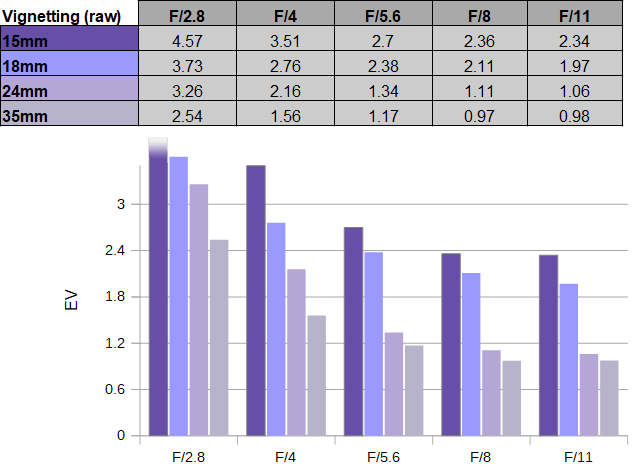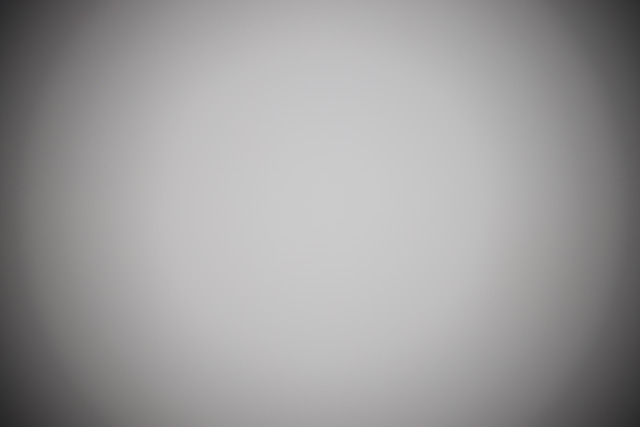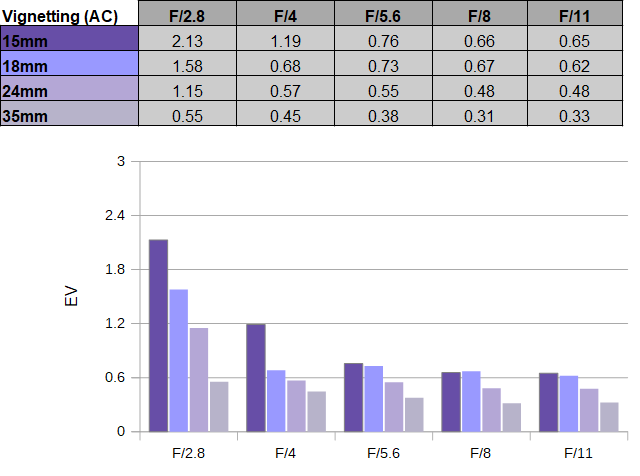|
Canon RF 15-35mm f/2.8 USM L IS - Review / Test Report - Analysis |
|
Lens Reviews -
Canon EOS (Full Format)
|
|
Page 2 of 3

Distortion
Image distortions tend to be a weak point with ultra-wide zoom lenses - especially in the mirrorless category. However, Canon stayed true to its tradition by correcting most of them. Of course, there are visible barrel distortions at the 15mm setting. But at ~2.8% they stay within the standards set by very good DSLR lenses. At 18mm the distortions have been reduced albeit you can spot a mustache-style sub-frequency in there. Beyond, the distortion switches to pincushion-style on a comparatively mild level.
If you prefer your images to be free of distortions, you can, of course, just rely on image auto-correction, which perfectly handles all this, as you can see below.
Vignetting
Some readers already "warned" us to prepare for very high RAW vignetting figures with this lens - and yes, at 15mm f/2.8 and a whopping 4.6EV (f-stops) they are even exceeding Zeiss levels and this is, I'm sorry to say, among the worst that we have seen here. That's almost 2 f-stops more than on comparable DSLR lenses and surely a side-effect of the shorter distance between the rear element and the image sensor. Stopping down reduces the issue substantially but it remains easily visible at all settings at 15mm and 18mm. The light falloff decreases at the more you zoom out but it's always very noticeable in the f/2.8 to f/4 range.
 FWIW, 4.6EV vignetting looks like this:
FWIW, 4.6EV vignetting looks like this:
 Now that's the RAW vignetting but image auto-correction comes to the rescue - at cost of increased sensor noise due to the signal boost. Surely also for this reason, Canon doesn't eliminate all vignetting but just reduces it down to a more bearable level. Thus at the wide end, you will still experience a heavy light fall-off of more than 2EV at f/2.8.
Now that's the RAW vignetting but image auto-correction comes to the rescue - at cost of increased sensor noise due to the signal boost. Surely also for this reason, Canon doesn't eliminate all vignetting but just reduces it down to a more bearable level. Thus at the wide end, you will still experience a heavy light fall-off of more than 2EV at f/2.8.

MTF (resolution)
Coming back to a more pleasant aspect again - the resolution. At 15mm, it's downright superb in the broader image center. Unsurprisingly the outer image field suffers a bit at f/2.8 but it remains very decent. You can spot some softness in the far corner pixels (beyond the coverage of the test spots) though. Stopping down lifts the borders/corners nicely. The borders are even entering excellent levels at f/5.6 and the corners are good to very good here. Beyond diffraction is limiting the quality albeit primarily in the image center until about f/11. Generally, f/16 and beyond should be avoided. The wide-open performance suffers a bit at 18mm f/2.8 in the borders/corners but the overall quality is actually slightly better at medium aperture settings. The same goes for 24mm. There's a slight drop in quality at 35mm primarily at f/2.8. Even so, the outer image field remains good and is top-notch from f/5.6 again.
The field curvature is low at 15mm but increases at longer settings. The centering quality of the tested sample was good but not perfect.
Please note that the MTF results are not directly comparable across the different systems!
Below is a simplified summary of the formal findings. The chart shows line widths per picture height (LW/PH) which can be taken as a measure of sharpness.
If you want to know more about the MTF50 figures, you may check out the corresponding Imatest Explanations

Chromatic Aberrations (CAs)
Lateral CAs are very well controlled. They stay around the 1px mark at the image borders across the range. You may just spot this when doing pixel peeping but it's really not an issue in real life.

Bokeh
We haven't taken the lens through our usual bokeh torture ground. However, we did take a couple of snaps at large-aperture settings during our field session.The first image below was taken at 35mm f/2.8, the 2nd one at 18mm f/2.8. I think it's safe to say that the out-of-focus blur is quite pleasing for an ultra-wide lens. There are some further shallow depth-of-field images in the sample image section.


Flare and Sun-Stars
Flare is always a hotly debated topic with ultra-wide lenses simply because they have to battle stray light more often than longer lenses. Generally, you can push ALL lenses beyond their limits - no SWC or ASC coating is ever perfect. It's just a question of how bad it gets. Below is a worst-case scenario with the sun positioned at the image borders in a rather darkish environment. As you can see, there's a blueish blob in the image corners. Glare is well controlled for a zoom lens.
The image was taken at f/13 and the "sun-stars" should be "quite" obvious here.

|